It’s often said that the victor writes the history, and I don’t think it’s a stretch to say that men, and society in general, have been victorious in writing an exclusionary narrative after ignoring women for centuries. Art history books, museums and other established institutions are undoubtedly lacking in female representation. That is not to mention that the women who have historically been able to “break through” and receive recognition are, more often than not, white. The Radical Women exhibition at the Hammer Museum aims to fill in some small blanks in the massive void that is Chicana and Latina representation in the art history canon.
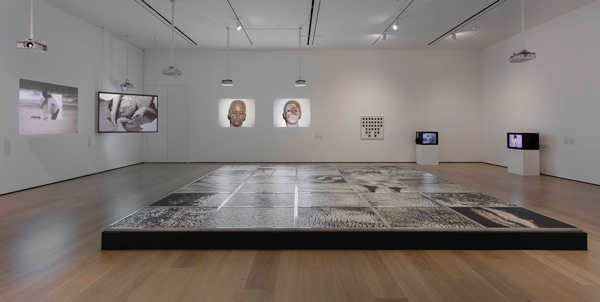
installation view,
“Body Landscape” theme. Hammer Museum, Los Angeles,
Photo: Brian Forrest.
“Radical Women: Latin American Art, 1960–1985” is wildly ambitious and impressive. The 120 women exhibited come from vastly different geographies, socioeconomic situations and personal histories. A problem frequently faced by peoples of various ethnic groups is that they are repeatedly represented in only one stereotypical way. Latin American countries with very different political and cultural makeups are mistakenly lumped into one analogous vision of a culture—a vision that is typically incorrect. And so, lazily those in El Norte project what Latin American art is supposed to look like, or is expected to look like, especially Latin American art created by women. The Hammer exhibition helps to establish unique voices that give actual shapes, actual names and actual visuals that exemplify the individuality of women working from 1960 to 1985.
All of the works in the exhibition have, in one way or another, something to do with the theme of the political body. A woman’s body is inherently political. For many people it has been, and is still viewed as an object to be sexualized: raped, plundered and eventually possessed, and turned into art by men. Most women are aware of the way their bodies are viewed by the time they reach puberty. To take proprietary rights over one’s own body and use it as a tool in one’s own art—in the way that many of the women in this show have done—is a revolutionary act.
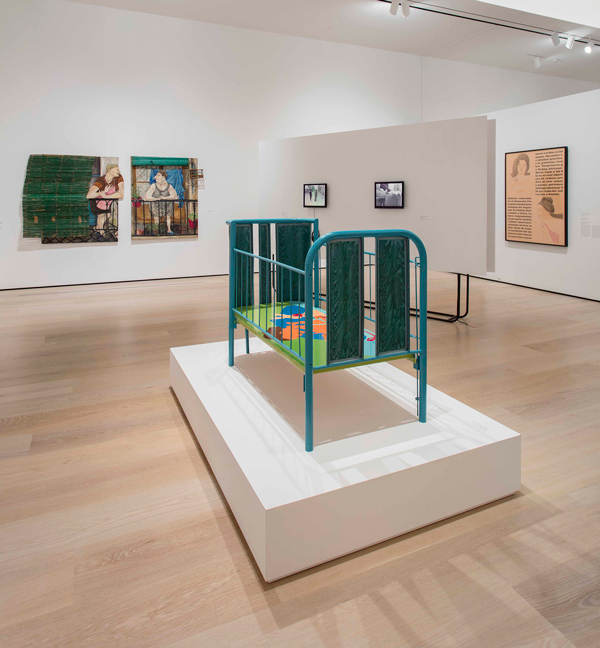
installation view,
“Social Places” theme. Hammer Museum, Los Angeles, Photo: Brian Forrest.
For centuries, women’s bodies have been represented in a limited variety of ways—the virgin, the plump and supple young thing to titillate viewers, the pregnant bearer of life and the respected matriarch, among others. By rejecting these heteronormative, patriarchal representations of women’s bodies, the artists in this exhibition present an alternate reality where women create their own definitions of themselves.
To fill the vacuum of over 20 years of Chicana and Latina art is no small undertaking, and I was taken aback by the sheer magnitude and scope of the work. I visited the exhibition again, and again, and again, and even after scouring the accompanying catalog felt like I still had more depths to plumb. I found this exciting, as the opposite is usually the case. To have the opportunity to dive into so many works by Chicana and Latina artists felt like a history lesson I had been thirsting for, from which I had previously been discouraged owing to the lack of information.
The two exhibition rooms are filled with works of nearly every medium—photography, sculpture, film, painting, drawing and experimental practices. The works are divided into seven themes—The Self-Portrait, Body Landscape, Performing the Body, Mapping the Body, Resistance and Fear, The Power of Words, Social Places and The Erotic. Mapped in this manner, the exhibition offers a natural and visually coherent path for the viewer to go down. Because of this structure, works by artists from different countries, such as Anna Maria Maiolino from Brazil and Margarita Paksa from Argentina, are placed next to each other. It’s important to note that many of the women in the exhibition did not identify as feminists, partly because they saw feminism as being closely linked to the colonialism and classism that they viewed as oppressive bourgeois forces.



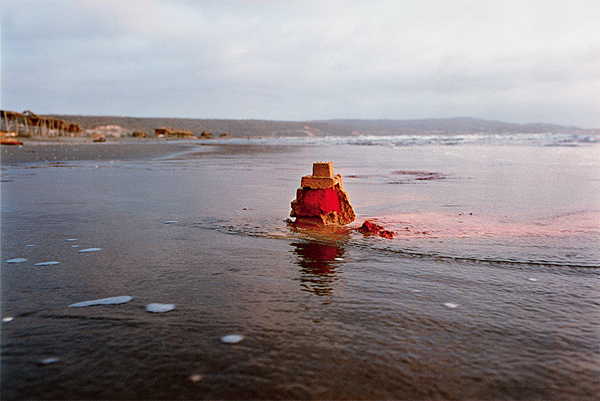
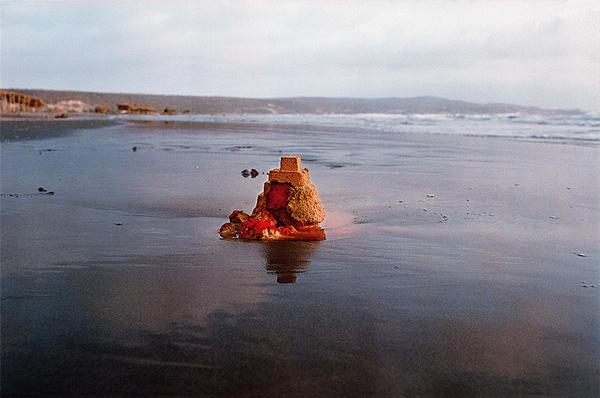
Sara Modiano Untitled, 1981, from the series Desaparece una cultura (A culture disappears), 1980–84, The Sara Modiano Foundation for the Arts (this image and above images)
It’s difficult to choose particular works to highlight, but there are a few that I can’t help but mention. One in particular is untitled (1981), from the series “Desaparece una cultura (A Culture Disappears)” by Sara Modiano. The series of photographs is remarkably poetic. It shows a time lapse of the ocean’s tide overtaking a red structure that appears similar to indigenous architecture of the area. After a series of photographs, the structure begins to dissolve, until eventually only a red dye stains the ocean. The symbolism of colonialism coming in from the sea to destroy structures, only to leave a sea of blood is obvious once stated; however, it remains poetically subtle upon first viewing of the series.
One work that I can’t believe isn’t in mainstream texts on conceptual art, along with artists like Marcel Duchamp and Piero Manzoni, is Sin Titulo (Untitled, 1970) by Gloria Gómez-Sánchez. The work is simply black text on a square, white background above a white table that reads, “EL ESPACIO DE ESTA EXPOSICION ES EL DE TU MENTE , HAZ DE TU VIDA LA OBRA” (“THE SPACE OF THIS EXHIBITION IS THAT OF YOUR MIND, MAKE YOUR LIFE THE WORK”). The fact that such an obviously exemplary work of conceptual art has been omitted from history is both a shame and a perfect example of why this collection of works is important.
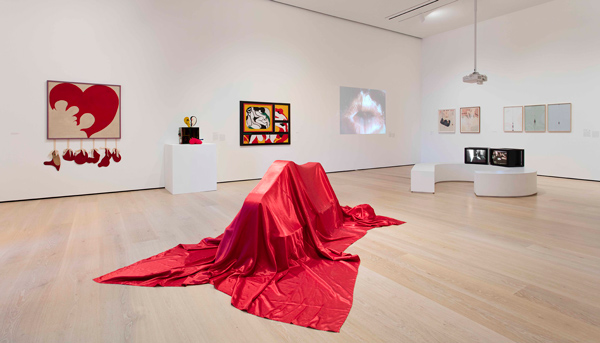
installation view, “Erotic” theme. Hammer Museum, Los Angeles, Photo: Brian Forrest.
In that same vein, Sonia Gutiérrez’ Seguiremos diciendo patria (We’ll Keep Saying Homeland, 1972) uses Pop art styling in a pointedly political and meaningful way—an aspect that was missing from much of the aesthetically driven Pop art produced by white males in America during the same period. The painting shows two brightly colored figures, presumably dead, who are hung upside down by their ankles. There is implied violence in the painting, which contrasts with the tightly rendered style.
Other impressive works include the large and impossible to overlook Epidermic Scapes (1977) by Vera Chaves Barcellos. These large, striking photographs resemble both abstract nature scenes and large prints of microscopic organisms.

Judith F. Baca Las Tres Marías (The three Marias), 1976, Smithsonian American Art Museum; Museum purchase made possible by William T. Evans
Judith F. Baca’s Los Tres Marías (The Three Marias, 1976) is another standout piece, possibly because it’s so well suited to 2017’s selfie-obsessed culture. I suspect that the Hammer considered this while placing the piece near the entrance of the exhibition, making it one of the first pieces viewers see. The work consists of two painted panels of fashionably badass Latina women, and a mirror panel in the center, which I’m sure the Hammer knows makes for fantastic free advertising when museum-goers inevitably post their own selfies beside the artwork.
As far as radical acts go, I think no pieces are better than Graciela Carnevale’s Acción del encierro (Lock-up Action, 1968). The photographs document an art show of Carnevale’s, at which she demonstrated the tyranny of fascism in Argentina by locking all of those in attendance inside the gallery. The unsuspecting attendants are stuck inside the gallery until eventually someone smashes one of the windows with a rock. The attendees don’t look terribly troubled in the photos; however, I can’t help imagining how the art world’s who’s who in LA would react if a similar stunt had been pulled at the Hammer itself during the show’s opening night.
On that note, I have to wonder if the women in the exhibit would be considered for a spot in the Hammer, or any other Los Angeles museum, if they were committing such acts and creating these radical works today in response to their respective socioeconomic cultures. Are Latina and Chicana women only invited to appear in shows after their respective time has come and gone, and they are in the safe space of history where they can’t disrupt the current status quo too much?


